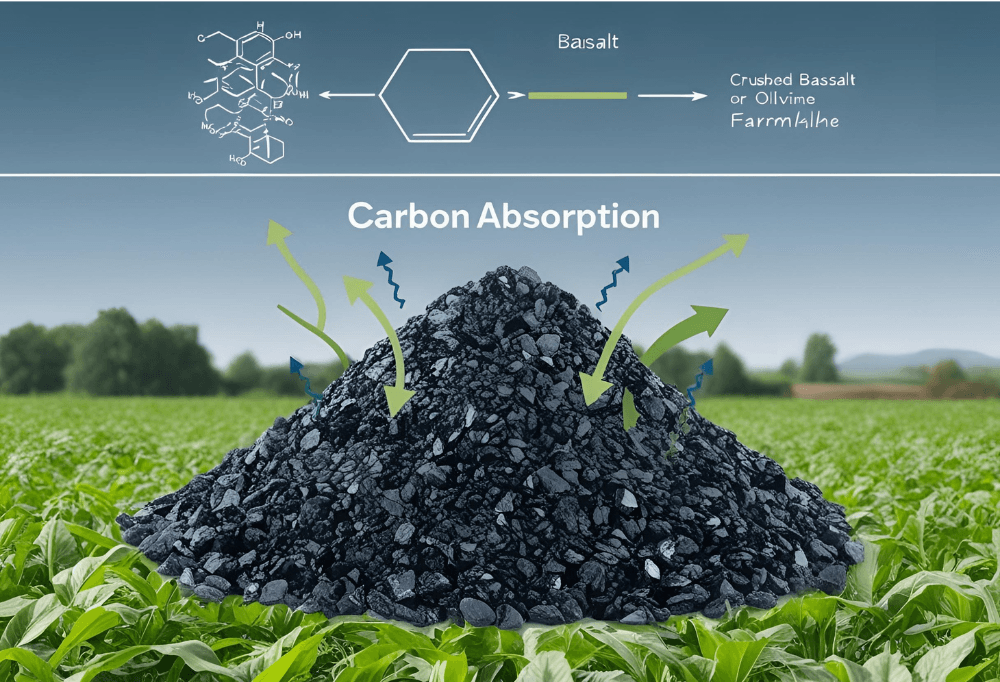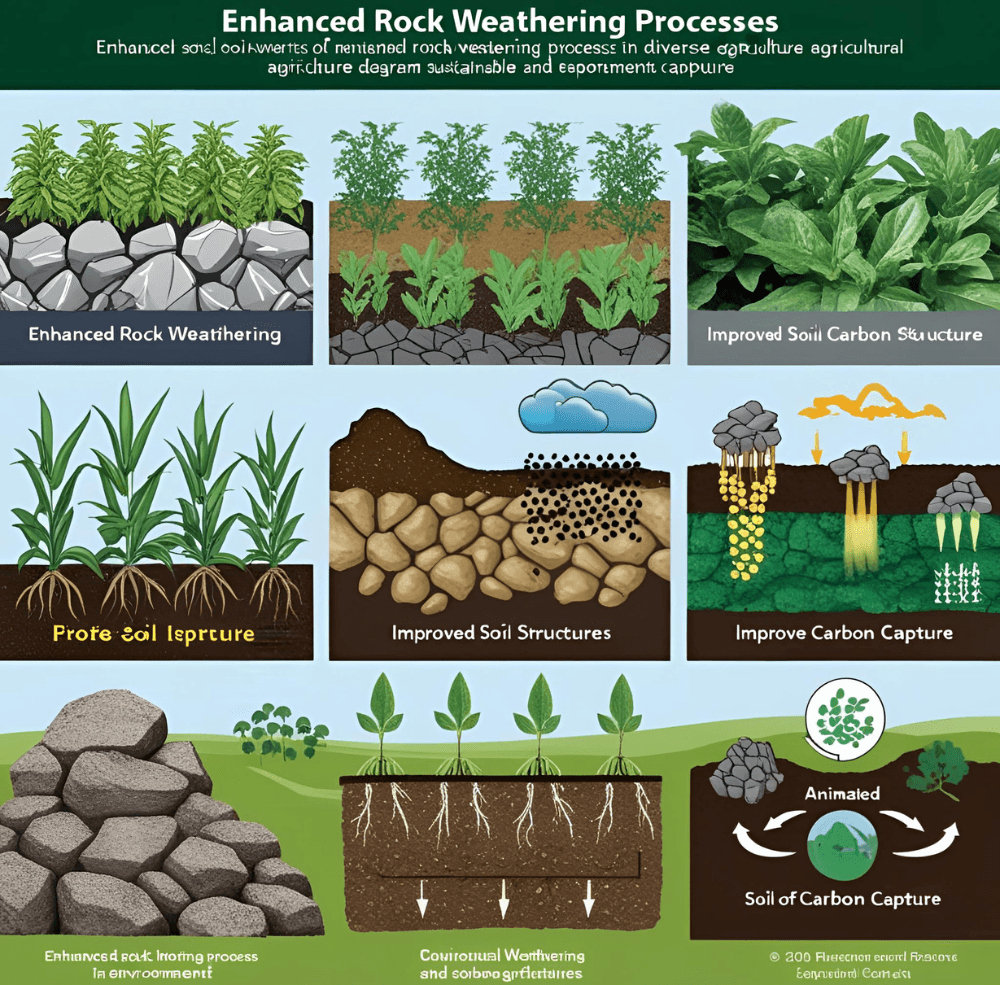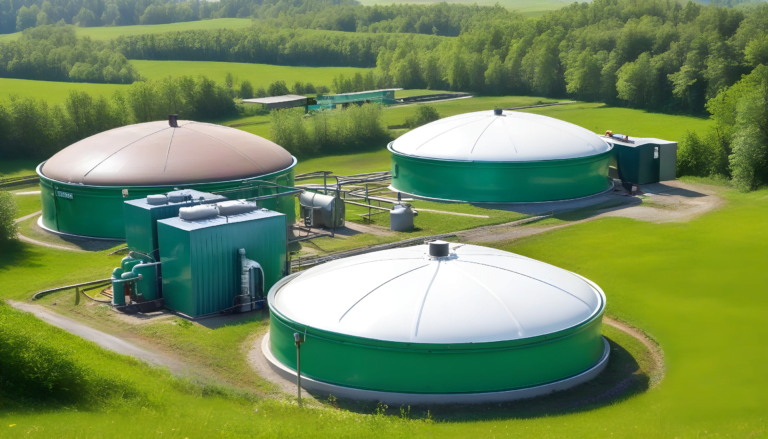Introduction to Enhanced Rock Weathering
Definition & Overview: What is Enhanced Rock Weathering?
Enhanced Rock Weathering (ERW) is a carbon removal technique that accelerates the natural breakdown of silicate rocks to capture atmospheric CO₂. In nature, rock weathering is a slow geological process that helps regulate Earth’s climate over millions of years. By grinding silicate-rich rocks (like basalt) into fine particles and spreading them over land, ERW speeds up this reaction, removing carbon dioxide at a much faster rate.
- Natural weathering vs. enhanced weathering: While rock weathering happens naturally over centuries, ERW amplifies this process by increasing the surface area of rocks exposed to the atmosphere.
- Why it matters: ERW is a scalable and cost-effective method to remove CO₂ from the air, making it an important strategy for climate change mitigation.

Scientific Basis: How Silicate Minerals Capture CO₂
The process of silicate rock weathering is a chemical reaction that binds CO₂ with minerals, locking it away in the form of stable carbonates. The reaction occurs when silicate-rich rocks, such as basalt, olivine, and feldspar, interact with rainwater and atmospheric carbon dioxide:

- Step 1: CO₂ dissolves in rainwater, forming carbonic acid.
- Step 2: Acidic water reacts with silicate minerals, releasing calcium, magnesium, and bicarbonate ions.
- Step 3: These ions eventually settle in the ocean, where they form stable carbonate sediments, permanently storing carbon.
Because this reaction is naturally exothermic (releases energy) and self-sustaining, it offers a long-term carbon storage solution without requiring additional energy inputs.
Historical Context: The Natural Role of Rock Weathering in Earth’s Climate
Rock weathering has played a critical role in Earth’s climate regulation for billions of years. Without it, Earth’s atmosphere might have accumulated excessive CO₂, leading to extreme global warming.
- Ancient CO₂ regulation: Over millions of years, mountain formation and tectonic activity exposed fresh silicate rocks, absorbing CO₂ and cooling the planet.
- Prehistoric climate shifts: Episodes like the Azolla event (50 million years ago) and the Himalayan uplift (40 million years ago) triggered massive CO₂ drawdowns, leading to cooler global temperatures.
- Modern enhancement: Humans can accelerate this natural process by spreading finely crushed basalt over farmland, enhancing CO₂ sequestration while also improving soil health.
Why Enhanced Rock Weathering is a Climate Change Solution
With rising CO₂ emissions from fossil fuels, industry, and deforestation, natural weathering alone isn’t fast enough to balance atmospheric carbon levels. Enhanced Rock Weathering offers a scalable and natural solution that:
✔️ Removes CO₂ permanently – Unlike trees, which can release CO₂ when they decay, carbon captured through silicate rock weathering is locked away for millennia.
✔️ Enhances soil fertility – The minerals released improve soil quality, boost crop yields, and reduce fertilizer dependency.
✔️ Uses abundant materials – Basalt and silicate rocks are widely available and can be sourced from quarries and mining waste.
As governments and industries seek cost-effective carbon removal strategies, Enhanced Rock Weathering is emerging as a leading climate change mitigation technology.
The Science Behind Enhanced Rock Weathering Carbon Removal
Chemical Reactions: How Enhanced Rock Weathering Captures Carbon
At its core, enhanced rock weathering (ERW) is a process that accelerates the natural breakdown of silicate minerals, leading to CO₂ sequestration. When silicate-rich rocks like basalt or olivine are finely ground and spread over land, they react with atmospheric carbon dioxide and rainwater, forming stable carbonate compounds. The key reaction follows this pathway:

In this process:
- Silicate minerals dissolve, releasing calcium and magnesium ions.
- These ions bind with CO₂, forming stable carbonate minerals (such as limestone) that remain locked in soil or eventually wash into oceans, permanently storing carbon.
- The reaction also increases soil alkalinity, improving nutrient availability for plants.
This inorganic method of carbon sequestration is significantly different from biological approaches like afforestation, which rely on temporary carbon storage in biomass.
Effectiveness & Limitations: How Much CO₂ Can Be Removed?
The CO₂ removal potential of ERW varies significantly based on environmental conditions and rock composition. Studies estimate that ERW could sequester up to 2-4 billion metric tons of CO₂ annually—a substantial contribution to global climate mitigation. However, some research highlights uncertainties:
- CarbonPlan found variability in ERW efficiency across different climates and soil types, suggesting real-world results may not always align with theoretical predictions.
- Some models overestimate sequestration potential by assuming complete mineral dissolution, whereas field studies show slower reaction rates in certain conditions.
- Scaling ERW globally requires massive infrastructure, including mining, grinding, and transportation of rock materials.
Despite these challenges, recent trials in agricultural lands have shown promising results, making ERW a viable long-term carbon removal strategy.
Factors Influencing Efficacy: Climate, Soil Type & Particle Size
Several variables affect the rate and efficiency of mineral carbonation in ERW:
- Climate: Warmer, wetter regions accelerate weathering, while arid climates slow down reactions.
- Soil Type: Acidic soils enhance silicate dissolution, whereas alkaline soils reduce reaction rates.
- Particle Size: Finely ground rock (below 10 microns) increases surface area, maximizing CO₂ uptake. However, excessive grinding is energy-intensive.
- Rock Type: Basalt is the most commonly used rock due to its abundance and high CO₂-reactivity, whereas olivine has a faster reaction rate but is less available.
Distinguishing from Organic Sequestration: How ERW Differs from Biological Carbon Storage
Enhanced rock weathering stands apart from biological carbon sequestration methods like afforestation, biochar application, and soil carbon enhancement:
| Method | Storage Type | Permanence | Scalability |
|---|---|---|---|
| ERW | Mineral carbonates | Permanent (1000+ years) | Scalable but requires infrastructure |
| Afforestation | Organic (biomass) | Temporary (fires, deforestation) | Land-intensive |
| Biochar | Organic (charred biomass) | Decades to centuries | Limited by feedstock |
Unlike biological storage, which is vulnerable to disturbances like wildfires or decomposition, mineral carbonation is highly durable, ensuring CO₂ remains locked away for thousands of years.
Key Takeaways
- Enhanced rock weathering captures CO₂ permanently through silicate mineral reactions.
- Climate, soil type, and rock particle size significantly affect ERW efficiency.
- Studies show uncertainties in CO₂ removal potential, but real-world trials are promising.
- ERW differs from organic sequestration as it offers long-term, stable carbon storage.
By understanding the science behind ERW and optimizing its efficiency, this approach has the potential to become a crucial tool in climate change mitigation strategies.
The Role of Basalt in Enhanced Rock Weathering
Enhanced Rock Weathering (ERW) is gaining traction as a viable carbon capture technique, and basalt rock dust is at the center of this process. But why is basalt the preferred choice, and what additional benefits and challenges does it present?
Why Basalt? The Ideal Choice for ERW
Basalt, a silicate-rich volcanic rock, is considered one of the most effective materials for Enhanced Rock Weathering due to:
- Fast Weathering Rate: Compared to other silicate minerals, basalt dissolves relatively quickly, accelerating carbon sequestration.
- High Surface Area: When finely ground, basalt rock dust has a larger reactive surface, enhancing its CO₂ absorption capability.
- Widespread Availability: Basalt is one of the most abundant volcanic rocks, making large-scale deployment feasible.
A key reason Enhanced Rock Weathering Basalt is favored is its ability to lock atmospheric CO₂ into stable carbonates, permanently removing carbon from the cycle while improving soil health.
Nutrient Co-Benefits: How Basalt Improves Soil Fertility
Unlike other rock dusts, basalt provides a dual advantage—carbon capture and soil enhancement. When basalt dissolves, it releases essential plant nutrients such as:
- Calcium (Ca): Strengthens plant cell walls, improving structural integrity.
- Magnesium (Mg): Critical for chlorophyll production and photosynthesis efficiency.
- Potassium (K): Enhances root development and water retention, boosting drought resistance.
Research suggests basalt rock dust application can increase crop yields while improving soil structure and water retention, making ERW an attractive climate-smart agricultural practice.
Regional Feasibility: Where Can Basalt Be Used for ERW?
The effectiveness of Enhanced Rock Weathering Basalt depends on geological availability and local soil conditions. Some ideal locations include:
- Volcanic regions (Iceland, Pacific Ring of Fire, Hawaii) – Naturally rich in basalt deposits.
- Agricultural hubs (Midwest USA, Brazil, India) – Where basalt application can improve soil fertility while capturing CO₂.
- Tropical zones – Higher rainfall accelerates silicate rock weathering, increasing carbon sequestration efficiency.
These areas not only have abundant basalt deposits but also benefit from its soil-enhancing properties, making ERW a practical solution.
Challenges of Using Basalt in ERW
Despite its advantages, there are some challenges and risks associated with large-scale basalt application:
- Heavy Metal Contamination: Some basalt sources contain trace amounts of nickel, chromium, and arsenic, which can accumulate in soils. Careful source selection and pre-treatment are needed to mitigate this risk.
- Cost & Logistics: Grinding basalt rock dust to the required fineness and transporting it to fields can be energy-intensive, potentially offsetting carbon savings.
- Long-Term Soil Impacts: Continuous application may alter soil pH and microbial communities, requiring long-term monitoring.
Basalt stands out as the most viable rock dust for Enhanced Rock Weathering, offering both carbon sequestration and soil fertility benefits. However, addressing contamination risks and optimizing logistics will be critical to scaling ERW efficiently
Real-World Applications & Companies Driving ERW Adoption
Enhanced Rock Weathering (ERW) is gaining momentum as a scalable climate change mitigation strategy. Governments, corporations, and agricultural sectors are increasingly adopting ERW due to its potential for long-term CO₂ sequestration and soil health improvement. This section explores key applications, real-world case studies, and the companies leading ERW adoption.
Agriculture & Soil Health: A Win-Win for Farmers and Climate
Integrating Enhanced Rock Weathering into agricultural practices is one of the most promising applications. By spreading silicate-rich rock dust (such as basalt) onto farmlands, farmers can:
✅ Improve Soil pH & Fertility – Basalt minerals replenish essential nutrients like magnesium, calcium, and potassium, reducing dependence on synthetic fertilizers.
✅ Enhance Crop Productivity – Studies indicate that mineral-rich soils improve plant resilience and yield, particularly in degraded agricultural lands.
✅ Capture CO₂ Naturally – As the silicate minerals react with CO₂ in rainwater, they form stable carbonates, locking away carbon for thousands of years.

Large-Scale ERW Projects: Companies Leading the Charge
Several pioneering companies are conducting field trials and deploying ERW at scale. Key players include:
🌱 Lithos Carbon – A U.S.-based startup leveraging ERW to improve soil health while offering carbon credit solutions to corporations. Their AI-driven technology optimizes rock dust application rates to maximize CO₂ removal.
🌍 UNDO – A UK-based company scaling ERW by working with farmers and industrial partners to spread finely ground basalt on agricultural land. They estimate a potential 1 billion tons of CO₂ removal per year with large-scale adoption.
🌳 The Future Forest Company – This organization combines ERW with afforestation efforts, using basalt rock dust on reforested land to boost carbon sequestration and tree growth.
📌 Industry Insight: Google, Microsoft, and Stripe have invested millions in carbon removal credits through ERW-based projects, recognizing its role in long-term CO₂ sequestration.
Corporate Carbon Offsetting: How Big Tech & Energy Companies Are Involved
As corporations face increasing pressure to meet net-zero emissions targets, Enhanced Rock Weathering is becoming a key tool in corporate sustainability strategies.
🏢 Microsoft & Shopify – Both companies have invested in ERW-based carbon removal credits, helping fund large-scale basalt applications.
⛽ Oil & Gas Giants (Shell, BP) – Major energy firms are exploring ERW as part of their carbon offset portfolios, complementing direct air capture (DAC) and other climate initiatives.
📈 Carbon Credit Market Expansion – ERW is gaining recognition in voluntary carbon markets, allowing companies to offset emissions by funding rock weathering projects.
Policy & Regulatory Landscape: Government Support & Incentives
Governments worldwide are recognizing Enhanced Rock Weathering as a viable CO₂ sequestration strategy and are implementing policies to support its adoption.
✔️ U.S. Department of Energy (DOE) – Funding ERW projects through the Carbon Negative Shot initiative, aiming for large-scale CO₂ removal solutions.
✔️ European Union (EU) – Exploring ERW inclusion in the Carbon Removal Certification Framework (CRCF), ensuring its verification for carbon markets.
✔️ Carbon Credits & Incentives – Countries like Canada and Australia are considering tax incentives for ERW adoption in agriculture and industry.
Enhanced Rock Weathering is no longer just a theoretical carbon removal technique—it is becoming a real-world climate solution with broad industry support. From agriculture and corporate sustainability to government-backed climate initiatives, ERW has the potential to sequester billions of tons of CO₂ while revitalizing degraded soils.
As ERW adoption accelerates, businesses and policymakers must work together to scale operations, refine measurement techniques, and ensure regulatory transparency. The coming years will determine whether ERW can fulfill its potential as a scalable, nature-based carbon removal technology.
Challenges & Uncertainties in Enhanced Rock Weathering
Enhanced Rock Weathering (ERW) presents a promising solution for climate change mitigation, but several challenges and uncertainties must be addressed before large-scale implementation. These challenges range from measurement difficulties to economic feasibility and ecological concerns.
Measurement & Verification: Ensuring Effective CO₂ Sequestration
One of the biggest challenges in Enhanced Rock Weathering carbon removal is accurately measuring how much CO₂ is permanently sequestered. Unlike direct air capture technologies, ERW relies on natural chemical reactions, making it difficult to track the long-term fate of captured carbon.
- Organizations like CarbonPlan have raised concerns about inconsistent measurement methodologies, which may lead to overestimations of carbon sequestration.
- The chemical weathering process takes years to decades, making immediate verification difficult.
- Advances in isotopic tracing and modeling techniques are needed to improve carbon accounting for CO₂ sequestration.
Energy & Cost Considerations: Is ERW Economically Viable?
The financial and energy costs associated with ERW are another significant hurdle. For this method to be viable on a global scale, the cost-benefit ratio of CO₂ removal must outweigh operational expenses.
- Rock Grinding & Processing: Silicate rocks, particularly basalt, must be ground into fine particles to accelerate weathering. This grinding process is highly energy-intensive.
- Transportation & Application Costs: The logistics of mining, transporting, and spreading crushed rock over vast agricultural lands can be expensive and carbon-intensive.
- Research is ongoing to explore low-energy grinding techniques and localized rock sourcing to reduce carbon footprints associated with rock processing.
Potential Ecological & Environmental Risks
While ERW is generally considered environmentally friendly, large-scale application introduces potential risks:
- Soil Alkalization: Silicate rock weathering increases soil pH, which could negatively impact soil microbial communities and plant growth in certain ecosystems.
- Heavy Metal Contamination: Some silicate rocks contain trace heavy metals that may leach into the environment over time, posing potential toxicity risks.
- Water Chemistry Disruptions: ERW alters soil and water mineral compositions, which could have unforeseen effects on aquatic and terrestrial ecosystems.
To mitigate these risks, further studies on long-term environmental impacts and proper site selection are crucial before scaling up ERW projects.
Scalability Issues: Barriers to Widespread Adoption
Despite its potential, ERW faces significant scalability challenges that limit widespread adoption:
- Logistical Constraints: The sheer volume of rock required for meaningful CO₂ removal is massive, requiring efficient global supply chains.
- Public Awareness & Policy Gaps: Unlike afforestation or direct air capture, Enhanced Rock Weathering is relatively unknown to policymakers and the general public, leading to limited funding and regulatory support.
- Regulatory Frameworks: There is currently no standardized policy for ERW implementation, making large-scale projects difficult to regulate and monitor.
Looking Ahead: Overcoming These Barriers
To overcome these challenges, researchers and policymakers must focus on:
- Developing better CO₂ measurement tools to accurately track sequestration.
- Improving energy efficiency in rock grinding and application methods.
- Addressing environmental risks through controlled pilot studies.
- Building public and government support to create funding mechanisms and regulatory frameworks for large-scale ERW projects.
With ongoing technological advancements and increased investment, Enhanced Rock Weathering could play a crucial role in global carbon removal strategies, provided its challenges are systematically addressed.
Future Prospects & Innovations in Enhanced Rock Weathering
Advances in Rock Grinding Technology
To accelerate CO₂ sequestration, optimizing the particle size of silicate rock weathering materials like basalt is crucial. Research shows that finer rock particles have a higher surface area, allowing for faster chemical reactions with atmospheric CO₂. Innovations in rock grinding technology, such as mechanochemical processing and nano-grinding techniques, are improving efficiency while reducing energy consumption. Scientists are also investigating the potential of microbial-assisted rock breakdown to enhance dissolution rates naturally.
AI & Remote Sensing in Monitoring
Tracking the real-world impact of enhanced rock weathering (ERW) is a major challenge. AI-driven remote sensing and machine learning models are now being developed to analyze soil pH changes, mineral composition, and carbon capture rates. Satellite imagery and ground-based spectrometry help researchers monitor ERW’s impact at scale, ensuring accurate CO₂ sequestration assessments. Blockchain technology is also being explored to create verifiable carbon credits linked to ERW projects.
Hybrid Carbon Removal Strategies
To maximize carbon removal, ERW is being integrated with complementary approaches such as:
- Biochar application – Enhancing soil carbon storage while improving ERW reaction rates.
- Regenerative agriculture – Using ERW-treated soils to boost plant growth and further sequester carbon.
- Ocean-based sequestration – Exploring the potential of marine ERW, where silicate minerals could increase ocean alkalinity and absorb atmospheric CO₂ more efficiently.
Global Adoption Potential
By 2050, enhanced rock weathering could play a crucial role in achieving net-zero emissions, with large-scale field trials in the US, UK, and Australia demonstrating promising results. According to climate models, ERW could capture 2-4 billion tons of CO₂ annually if adopted globally. However, financial incentives, clear regulatory frameworks, and public awareness campaigns will be key to widespread implementation.
Conclusion: The Future of Enhanced Rock Weathering for Carbon Removal
Summary of ERW’s Potential
Enhanced rock weathering (ERW) represents a scalable, nature-based climate solution that accelerates the Earth’s natural CO₂ sequestration processes. By spreading finely ground silicate rocks over farmland and degraded lands, ERW can help remove substantial amounts of atmospheric CO₂ while also enriching soil health.
Balancing Benefits & Challenges
While ERW offers a low-energy, long-term carbon removal solution, its effectiveness depends on multiple factors, including regional climate conditions, rock mineralogy, and soil composition. Research is ongoing to address challenges such as:
- The energy footprint of rock mining and grinding.
- The cost-effectiveness of large-scale deployment.
- Potential ecological impacts, such as shifts in soil pH and nutrient availability.
Final Thoughts: ERW as Part of a Broader Climate Strategy
Despite its promise, enhanced rock weathering carbon removal should not be viewed as a silver bullet. Instead, it should be integrated into a diverse climate change mitigation portfolio alongside reforestation, direct air capture (DAC), and renewable energy transitions. Nature-based solutions like ERW have the potential to complement technological innovations, ensuring a balanced and resilient approach to fighting climate change.
Explore More Carbon Capture and Sustainable Energy Innovations
If you found Enhanced Rock Weathering fascinating, check out these related articles on cutting-edge climate solutions:
-
Direct Air Capture vs. Carbon Capture – Understand the key differences and effectiveness of these carbon removal technologies.
-
Biogas Plants: Turning Waste into Energy – Learn how organic waste is converted into renewable energy.
-
Micro Algae Biofuel: The Future of Sustainable Energy – Discover how algae-based biofuels could revolutionize clean energy production.
-
Ambient Energy Harvesting: Power from the Environment – Explore how we can generate energy from natural sources like heat, light, and vibrations.
🌍 Stay informed about the latest advancements in sustainable energy—dive into these articles today!






